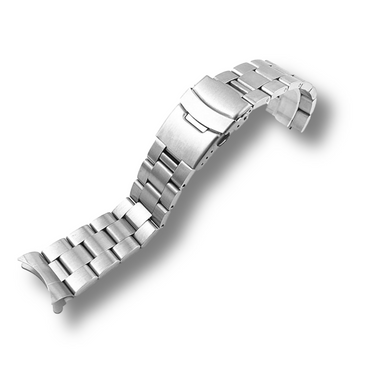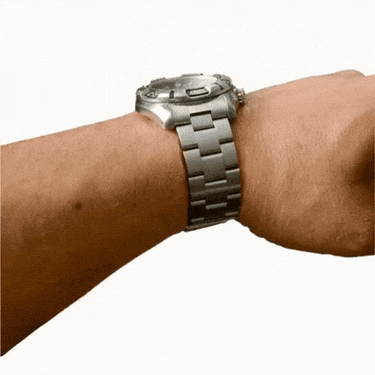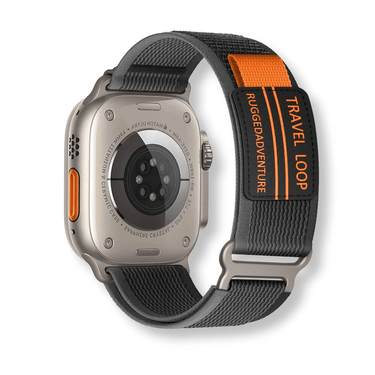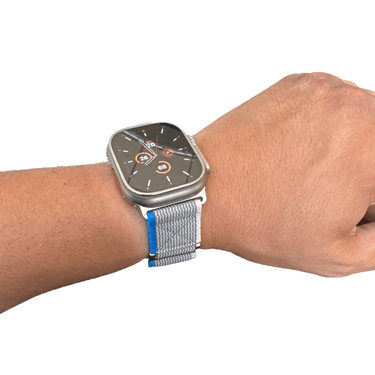Introduction: Why Use a GPS-Enabled Watchband?
If you're an outdoor enthusiast, you know how important it is to have the right gear. And in today's world, one of the most important tools you can have is a GPS-enabled watchband.
Sure, you could bring along a separate GPS device or use your smartphone, but nothing beats the convenience and accuracy of having this information at your wrist. But what are the benefits of using a GPS-enabled watchband for outdoor activities?
First and foremost, it allows you to track your location and stay on course while hiking, camping, or exploring unfamiliar terrain. No more getting lost or taking wrong turns – your watchband will keep you on track.
In addition to navigation, GPS-enabled watchbands also provide valuable metrics such as distance traveled, elevation gain/loss, and even heart rate monitoring. This information can be incredibly useful for training purposes or simply tracking your progress over time.
But how do these devices work? Essentially, they use satellite signals to determine your location and calculate your speed and direction of travel.
Some devices also incorporate barometric sensors for more accurate altitude readings. Now that we've covered why you should consider using a GPS-enabled watchband for outdoor activities and how they work let's dive into what factors to consider when choosing the right one for you.
Choosing the Right GPS-Enabled Watchband
Choosing the right GPS-enabled watchband can make or break your outdoor adventure. You don't want to be stranded in the middle of nowhere with a dead battery or an inaccurate device. When it comes to selecting a watchband, there are several factors to consider.
Battery Life
The first and most important factor to consider is battery life. Having a watchband with long-lasting battery life is crucial when you're spending long hours outdoors without access to electricity. While some devices have batteries that last only a few hours, others can last for days or even weeks without needing a charge.
When considering battery life, it's important to keep in mind how often you'll be using the device and what kind of activities you'll be doing. For example, if you plan on doing multi-day hikes in remote areas with no access to electricity, it's best to choose a watchband with extended battery life.
Durability
The second factor to consider is durability. A GPS-enabled watchband should be able to withstand harsh outdoor conditions such as extreme temperatures, water exposure, and rough terrain.
A durable device will not only last longer but also give you peace of mind during your adventures. Look for watches that are shock-resistant and waterproof, so they can handle accidental drops and splashes without getting damaged.
Accuracy
The third factor to consider is accuracy. A GPS-enabled watchband should provide accurate location tracking so that you don't get lost or stranded during your outdoor activities. Some devices have more accurate GPS sensors than others; therefore, it's important to look for watches with high accuracy ratings and reliable sensors that won't fail you when you need them most.
Comparison of Popular GPS-Enabled Watchbands
Now that you know what factors to consider when choosing a GPS-enabled watchband, it's time to compare some popular options on the market.
Garmin Fenix 5X
The Garmin Fenix 5X is a well-known and highly-rated GPS-enabled watchband that features long battery life, durable construction, and accurate location tracking. It's perfect for outdoor enthusiasts who need a reliable device for extended trips.
Suunto 9 Baro
The Suunto 9 Baro is another popular option among outdoor adventurers. This watchband boasts an impressive battery life of up to 120 hours, as well as durable construction and accurate location tracking.
Apple Watch Series 6
If you're looking for a more modern and versatile option, the Apple Watch Series 6 is worth considering. While not specifically designed for outdoor activities, this watch features GPS tracking, water resistance, and various health tracking features that can enhance your outdoor experience.
Ultimately, the best GPS-enabled watchband for you will depend on your specific needs and preferences. Consider the factors mentioned above and do some research before making your final decision.
Using Your GPS-Enabled Watchband for Hiking and Camping
Tracking your location with your GPS-enabled watchband
GPS-enabled watchbands are a game-changer when it comes to outdoor activities like hiking and camping. With the ability to track your location in real-time, you can feel confident that you won't get lost on the trail. To use this feature effectively, make sure you have a clear view of the sky so that the GPS can pick up your location accurately.
Additionally, some watchbands come with pre-loaded maps of popular trails, which can be incredibly helpful if you're exploring a new area. When planning your route, don't rely solely on your watchband's navigation system.
Make sure to bring a detailed map and compass as backup in case of technical difficulties or battery failure. It's also important to familiarize yourself with the terrain before heading out - know how elevation changes will impact your pace, identify potential hazards like steep drop-offs or river crossings, and plan for rest breaks as needed.
Navigating trails using your GPS-enabled watchband
In addition to tracking your location, many GPS-enabled watchbands offer turn-by-turn navigation guidance when following pre-programmed routes or waypoints. This can be especially helpful when exploring new areas or when navigating complex trail systems with multiple intersecting paths.
To use this feature effectively, take some time to familiarize yourself with how it works before heading out on the trail. Learn how to set waypoints for key destinations along the route and practice navigating between them using both visual cues (like signs or landmarks) and audible alerts from the watchband.
Tips for conserving battery life during extended outdoor trips
One downside of using a GPS-enabled watchband for extended outdoor activities is that they require significant battery power to function properly. To avoid running out of juice in the middle of your adventure, consider these tips for conserving battery life: - Turn off unnecessary features: If you're not using the heart rate monitor or other advanced features, turn them off to save battery life.
- Use airplane mode: Many watchbands have an airplane mode that disables all wireless connections. This can significantly extend battery life, especially when you're out of range of cell towers.
- Adjust the GPS settings: Some watchbands allow you to adjust the frequency at which they update your location. Consider using a lower update rate to conserve power.
- Bring a portable charger: If you're planning an extended outdoor trip, consider bringing a portable charger to keep your watchband powered up and ready for action. With these tips in mind, you can confidently use your GPS-enabled watchband for hiking and camping without worrying about running out of battery power.
Using Your GPS-Enabled Watchband for Running and Cycling
The Ultimate Tracker for Runners and Cyclists
When it comes to running or cycling, tracking your progress is essential. With a GPS-enabled watchband, you can track not only your distance and speed but also other important metrics such as heart rate, cadence, and even stride length. This information can be used to monitor your training progress and help you improve your performance.
Tracking Distance and Speed
One of the primary benefits of using a GPS-enabled watchband while running or cycling is the ability to accurately track distance and speed. The watchband uses GPS technology to pinpoint your location, so it can accurately measure the distance you've traveled. It also tracks your speed in real-time, so you always know how fast you're going.
In addition to tracking distance and speed during a workout, many watchbands also allow you to see a summary of your performance after the workout is complete. You can view information such as total distance traveled, average pace per mile/kilometer, and even elevation gain/loss.
Other Important Metrics
In addition to tracking distance and speed, many GPS-enabled watchbands also track other important metrics that are useful for runners and cyclists. These include:
- Heart rate: Many watchbands have built-in heart rate monitors that allow you to track your heart rate in real-time during a workout. - Cadence: For runners, cadence is an important metric that measures how many steps they take per minute.
A higher cadence generally means a more efficient stride. - Stride length: Another important metric for runners that measures the length of each stride taken.
Recommended Apps and Features
When choosing a GPS-enabled watchband for running or cycling, there are certain apps and features that are particularly useful. Some of these include: - Strava: A popular app among runners and cyclists that allows you to track your workouts, compare your performance to others, and join challenges.
- Training plans: Many watchbands come with built-in training plans that can help you improve your performance over time. - Virtual coaching: Some watchbands also offer virtual coaching features that provide personalized training tips and advice.
Overall, a GPS-enabled watchband is an essential tool for any runner or cyclist looking to track their progress and improve their performance. With accurate tracking of distance, speed, heart rate, cadence, and stride length, along with useful apps and features such as Strava and virtual coaching, there's no better way to take your workouts to the next level.
Advanced Features of GPS-Enabled Watchbands
Heart Rate Monitoring: The Ultimate Performance Enhancer
If you're a serious athlete, you already know that tracking your heart rate is key to optimizing your performance. GPS-enabled watchbands with heart rate monitoring capabilities take data collection to the next level, offering real-time feedback on your cardiovascular activity. This feature allows you to train more effectively and avoid overexertion by tracking your heart rate zones.
But heart rate monitoring isn't just for elite athletes. Whether you’re an amateur jogger or weekend hiker, the benefits of heart rate monitoring can help you push yourself further and reach your goals faster.
Sleep Tracking: The Secret to Improving Your Recovery Time
Incorporating sleep tracking into your routine can dramatically improve your recovery time between workouts and outdoor activities. By providing insight into your sleep patterns, these devices help identify factors that may be disrupting the quality of your rest.
With this information, you can make adjustments to improve the overall quality of your sleep and optimize recovery time. Getting better sleep translates directly into better performance and more enjoyable outdoor experiences.
Smart Notifications: Stay Connected Without Sacrificing Your Time in Nature
One concern many people have when considering using technology during outdoor activities is becoming too disconnected from nature. However, with smart notification features on GPS-enabled watchbands, this is no longer an issue.
You can stay connected with important alerts while still immersing yourself in the beauty of nature around you. Whether it’s receiving texts or calls from loved ones or notifications from important apps, smart notifications allow for a balance between staying connected and enjoying uninterrupted time outdoors.
A Word on Advanced Features:
While advanced features offer many benefits, they do come at a cost in terms of battery life and device complexity. It's important to consider whether the features you want are worth the added weight and potential distraction during your outdoor activities. When looking at GPS-enabled watchbands with advanced features, be sure to choose one that fits your specific needs.
It's also important to understand how these features work and how to use them effectively. With proper understanding and utilization, advanced features can take your outdoor experiences to the next level.
Maintenance Tips for Your GPS-enabled Watchband
Don't Neglect Your Watchband
You've invested in a high-quality GPS-enabled watchband, so don't let it go to waste by neglecting its maintenance! Proper care will ensure your device stays functional and lasts for years to come. Start by regularly cleaning your watch.
This might seem like a small detail, but dirt and grime can build up over time and interfere with the device's sensors. When cleaning your watchband, use a soft cloth or brush and avoid using harsh chemicals that could damage the device.
Wipe down the band as well as the screen to keep it free of smudges and fingerprints. If your band is particularly dirty, consider soaking it in soapy water for a few minutes before wiping it down.
Keep It Charged
A dead battery is frustrating no matter what kind of device you have, but losing GPS functionality during outdoor activities can be downright dangerous! Make sure you keep your watch charged up before heading out on any trips or activities.
Some GPS-enabled watchbands have longer battery lives than others, so be aware of how long yours typically lasts so you can plan accordingly. If you'll be away from power sources for extended periods of time, consider investing in an external battery pack or portable solar charger to ensure that you can keep your watch charged up no matter where you are.
Best Practices for Keeping Your Device in Good Working Condition
Avoid Extreme Temperatures
Most GPS-enabled watchbands are built to withstand outdoor conditions, but extreme temperatures can take their toll on any electronic device. Avoid exposing your watchband to temperatures above 120 degrees Fahrenheit or below -20 degrees Fahrenheit as these extreme temperatures could cause damage to the batteries or internal components. If you know you'll be heading into particularly hot or cold environments, consider investing in a protective case or cover to help insulate your watchband from the elements.
Be Gentle with Your Device
It might seem like an obvious point, but it bears repeating: be gentle with your GPS-enabled watchband! These devices are designed to be durable, but they're not indestructible.
Avoid dropping your watch or exposing it to unnecessary impacts that could cause damage. Similarly, be careful when manipulating buttons and controls on the device.
While it's unlikely that you'll break anything by pushing a button too hard, overuse could lead to premature wear and tear on the device's components. Always treat your GPS-enabled watchband with care and respect if you want it to last for years to come.
Conclusion
After thoroughly examining the benefits of GPS-enabled watchbands for outdoor activities, it is clear that these devices are a must-have for any adventurer. The accuracy and convenience they provide make them an indispensable tool for hikers, runners, cyclists, and anyone else who enjoys spending time in nature. Whether you're navigating a new trail in the woods or trying to beat your personal best on a morning run, a GPS-enabled watchband can help you stay on track and achieve your goals.
With features like heart rate monitoring and smart notifications, these devices are much more than just glorified pedometers. So if you're serious about outdoor activities of any kind, I highly recommend investing in a quality GPS-enabled watchband.
Not only will it make your adventures safer and more enjoyable, but it will also give you the data you need to track your progress and improve over time. The world of outdoor sports is constantly evolving with new technologies being introduced every day.
While some may argue that relying too heavily on technology takes away from the adventure itself; however, when used properly GPS-enabled watchbands can enhance our experiences without detracting from them. So embrace the future of outdoor sports technology by adding a high-quality GPS-enabled watchband to your gear collection today!

























